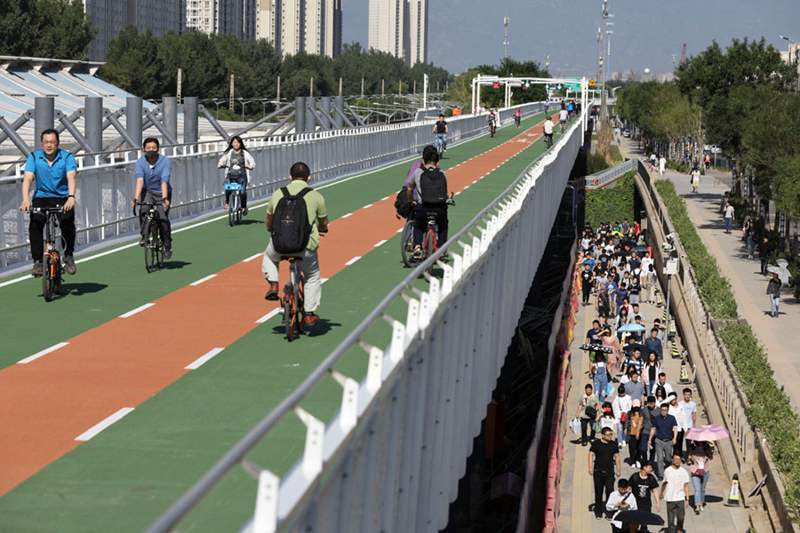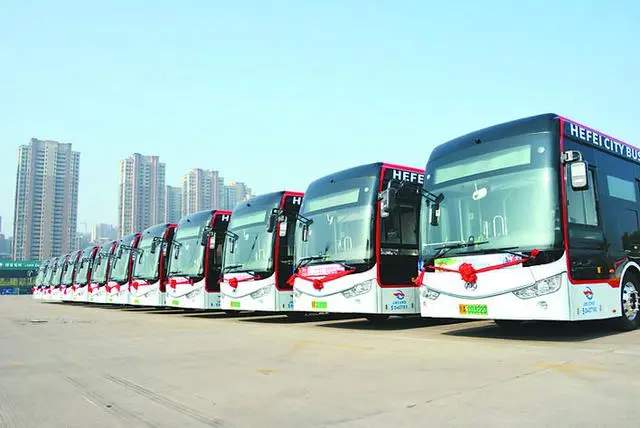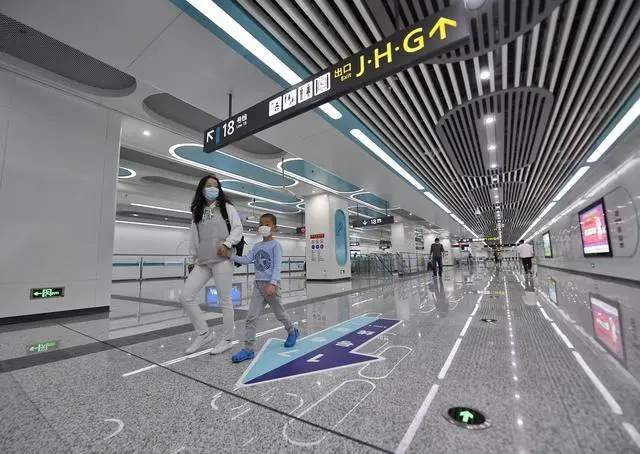Green, efficient transport modes benefit citizens across China
The ramping up of efforts to build cycleways, promote new energy buses, and improve rail transit networks has given people in cities across China more and more benefits through diversified green transport modes while contributing to the green and low-carbon development of the country.
Commuting by bike: a healthy new choice
Yue Qinglian, a 73-year-old woman who lives in Beijing’s Changping district, recently found a renewed passion for cycling, thanks to the bikeway near her home, the first to be built in Beijing.

Cyclists bike on the first bicycle-only lane near Longze subway station in Beijing, May 31, 2019. (chinadaily.com.cn/Zhu Xingxin)
"Cycling is good physical exercise, and I can enjoy the scenery along the way. I feel like something is missing if I don't go for a bike ride every day," Yue said.
The bikeway she rides on every day is 6.5 kilometers in length, of which 5.5 kilometers is a closed section where only non-electric bikes are allowed.
"There are green plants and ornaments on both sides of the road, which make the ride very enjoyable," she added.
The bikeway connects a renowned super-large residential community at one end and a cluster of Internet companies in Beijing at the other, making commuting by bike a preferred choice for many citizens.
"I used to drive to work, and it took me at least one hour to get to my office. Now, the commute only takes about half an hour by bike," said a man surnamed Zhang who works for an Internet company in Beijing. Cycling has now become one of his few hobbies.
There are about 11,600 people like Zhang who commute by bike on the bikeway, according to Liu Shuang, an executive of the bikeway management center of Changping district.
As of the end of November 2022, the bikeway has witnessed a cumulative total of 6.49 million rides, with the average daily number of rides standing between 4,000 and 9,000, Liu said.
"Compared to the time needed for commuting by private car and bus, commuting by bike on the bikeway cuts the time by 32 percent and 50 percent, respectively. Also, bike commuters can save on more than 1,500 tonnes of carbon emissions a year," Liu said, adding that the bikeway is currently being extended so that it will be connected to a slow traffic system covering Changping district, Haidian district, and Xicheng district of Beijing.
Green buses: a better travel experience
Hefei city in east China's Anhui Province has vigorously promoted new energy buses in recent years. Since 2018, all the newly added buses in the city have been pure electric buses, according to an executive from the passenger transport management department of the Hefei Transportation Bureau.

Photo shows a fleet of electric buses in Heifei city. (Photo/Hefei Evening News)
By the end of 2020, all the buses running in the central urban areas of the city were new energy buses, the executive said.
The new energy buses have been widely praised by citizens, as they provide a smoother travel experience.
Xiang Fan is a resident of Hefei city who used to dislike buses because he always felt uncomfortable on them. Ever since the buses he often takes were upgraded to new energy vehicles, he has enjoyed taking the bus to work and at weekends.
New energy buses don't have the roaring engines that bother Xiang. Furthermore, they are more spacious and start and stop more smoothly than traditional buses, advantages that have significantly improved citizens' travel experience.
Data showed that Hefei Public Transport Group Co., Ltd., the operator of bus services in Hefei, has a total of 3,440 new energy buses in service, accounting for 98 percent of its vehicles running in the city.
In 2021, buses in Hefei registered a total reduction of 155,700 tonnes of carbon dioxide emissions, which was equivalent to planting more than 8.5 million trees, according to Yang Haibing, manager of the technical management department of Hefei Public Transport Group Co., Ltd.
In addition to optimizing energy structure, the bus operator has also made great efforts to improve its transport network.
“By analyzing data on the relevant factors, we can realize accurate deployment of vehicles so as to provide the greatest convenience for citizens and contribute to energy conservation and carbon emissions reduction efforts," said Bu Zexiang, manager of the operations management department of Hefei Public Transport Group Co., Ltd.
Hefei will continue to promote smaller, faster, and more flexible buses and expand its bus service coverage so that more citizens can take buses near their homes, said an executive of the passenger transport management department of the Hefei Transportation Bureau.
Moreover, the city plans to accelerate the integration of bus and rail transit networks to solve the "last kilometer" problem in public transport, the executive added.
Close-knit rail transit network: bringing greater convenience to citizens
China’s increasingly close-knit rail transit network has made the environmentally-friendly transport mode of taking the subway a popular choice for more people.
Chengdu, capital of southwest China's Sichuan Province, has opened 13 rail transit lines, with their total length reaching 558 kilometers, according to an executive of the Chengdu Transportation Bureau.

Photo shows a station of subway Line 18 in Chengdu, Southwest China's Sichuan Province. (Photo/Xinhua)
"Our rail transit network will continue to expand. We are striving to increase the total length of our rail transit lines under construction and in operation to over 1,000 kilometers by the end of 2025, connect our two airports to the rail transit network, and basically form half-hour rail transit commuting circles," said the executive.
"In the past it took me more than an hour to go from the south to the north of the city. Now, it only takes about half an hour by subway, which is so much faster and more convenient," said a woman surnamed Liu who has lived in Chengdu for many years, and witnessed how the city's rail transit network was created and how rapidly it has expanded over the years.
Chengdu's rail transit network handles more than 60 percent of the passenger trips in the city, and has an on-schedule rate of 99.99 percent, according to relevant statistics.
As of August 2022, the city’s rail transit network had handled over 9 billion passenger trips, with the maximum daily passenger throughput exceeding 7.22 million, data suggested.
The city has also actively integrated smart technologies into subway services. Chengdu Rail Transit Group Co., Ltd. has taken the lead in China to promote the comprehensive application of smart technologies in security checks, ticketing services, and body temperature measurements in the city’s rail transit lines.
Smart technologies now cover all the turnstiles and security checkpoints of 287 stations along 12 subway lines in the city, increasing security check efficiency by more than 20 percent compared to that of traditional security check gates.
"So far, 11 subway lines in Chengdu have launched a service that guarantees different temperatures in different parts of the trains, built special rooms for mothers and expectant mothers, installed call bells in some stations to ensure timely services for special groups, including people with disabilities, and provided barrier-free booking services," said an executive from Chengdu’s subway operator.
According to a credible source, the city also plans to deepen the integration of its rail transit network and bus services, open five special tourist lines, and improve more than 20 shuttle bus lines.
Photos
Related Stories
- China's waterway freight volume up 4.8 pct in Jan-Oct
- China sees accelerated speed of intelligent port construction
- China speeds up efforts to expand, renovate expressways
- China's transport investment up 6.3 percent in first three quarters
- China's international civil aviation transport continues to recover in Q3
- China improves pedestrian, bicycle systems for better, greener urban transport
- China ramps up transport investment to bolster economy
- China's transport infrastructure greatly improves over last decade: report
- China witnesses remarkable transportation improvement over past 10 years
- China's container throughput rises 11.2 pct in July
Copyright © 2022 People's Daily Online. All Rights Reserved.









